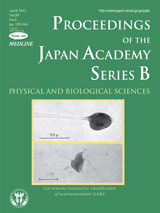About the Cover
Vol. 89 No. 4 (2013)
A highly sensitive method for measuring γ₋aminobutyric acid(GABA)was developed. This method consists of a combination of the enzymatic GABA assay of Jakoby and Scott with the enzymatic cycling technique of Lowry et al. Using this method, GABA analyses were made on single nerve cell bodies of different types isolated from the central nervous system (CNS) of the cat. Average GABA concentration of large cells of the dorsal part of Deiters’ nucleus (dorsal Deiters’ cells, shown in upper part of the illustration) was remarkably higher than those of spinal motoneurons (shown in lower part), spinal ganglion cells, etc.
It had been known that Purkinje neurons in the cerebellar vermis send axons to dorsal Deiters’ cells in the brain stem, and from inhibitory synapses with these cells. Therefore, the cerebellar vermis was surgically removed beforehand in cats, and the GABA concentration of isolated dorsal Deiters’ cells was measured. The GABA concentration was greatly reduced by the pretreatment, which suggests that GABA was concentrated in presynaptic axon terminals of Purkinje neurons attached to the isolated dorsal Deiters’ cells.
The above results, together with other lines of evidence as presented in K.Obata’s review in this issue, support the notion that GABA serves as an inhibitory neurotransmitter of Purkinje neurons forming synapses with dorsal Deiters’ cells and further a more general concept that GABA is an important neurotransmitter in mammalian CNS.
Member of the Japan Academy




